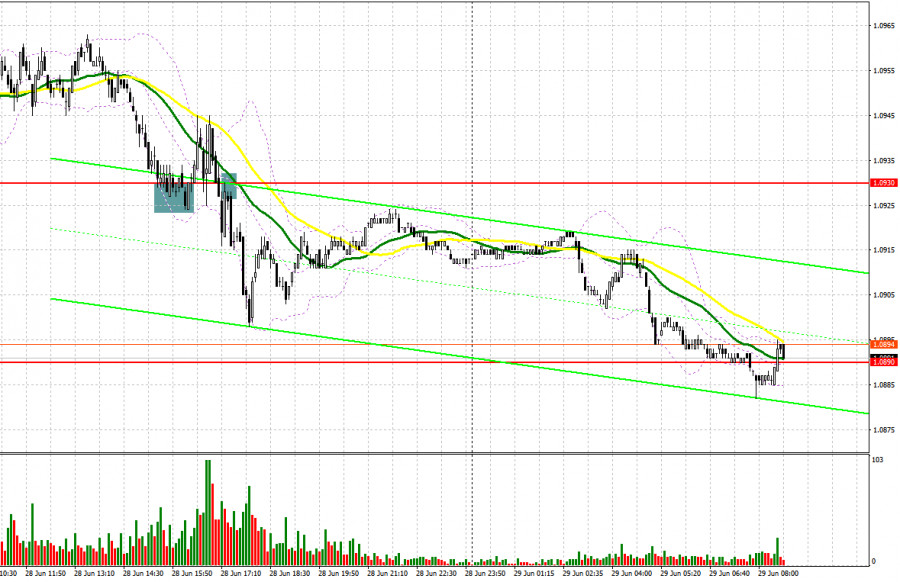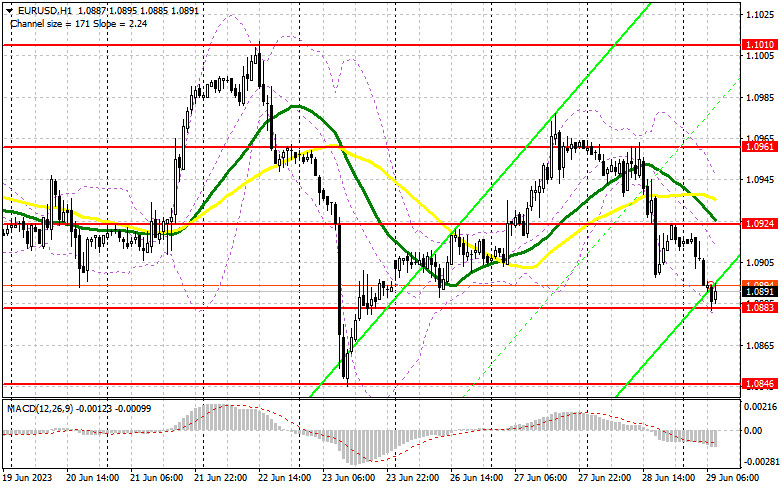
Yesterday, there were several entry points. Now, let's look at the 5-minute chart and figure out what actually happened. There were no entry points in the morning due to low volatility. The American session was much more buoyant. A false breakout of 1.0930 gave a buy signal. However, after moving up by 15 pips, the pressure on the euro returned. On the second attempt, a breakout occurred and a n upward retest of 1.0930. It created a sell signal with a drop by more than 30 pips.

When to open long positions on EUR/USD:
Yesterday, several high-ranking central bank officials made their speeches. All of them spoke in favor of further aggressive tightening. The economies of many countries remain stable which means they can continue raising rates to tame inflation. It triggered a decline in the euro. Demand for the US dollar rose. Apparently, the Fed will hardly skip a rate increase in July. The regulator will raise rates contrary to the dovish expectations of analysts. It exerts pressure on EUR/USD.
I plan to enter the market only on a fall and a false breakout of the support level of 1.0883, which was formed in today's Asian session. Only this will give a buy signal that could help the pair grow to the resistance level of 1.0924. At this level, the moving averages are passing in positive territory. Only another sharp jump in inflation in Germany could boost a bullish bias for the euro. A breakout and a downward test of 1.0924 may bolster demand for the euro. so, the pair is likely to hit a weekly high of 1.0961. A more distant target will be the 1.1010 level where I recommend locking in profits.
If EUR/USD declines and bulls fail to protect 1.0883, which may be facilitated by the eurozone weak reports and the economic bulletin from the ECB, the pressure on EUR/USD will increase. Therefore, only a false breakout of the support level of 1.0846 will create new entry points into long positions. You could buy EUR/USD at a bounce from 1.0883, keeping in mind an upward intraday correction of 30-35 pips.
When to open short positions on EUR/USD:
Bears managed to take the upper hand yesterday. They are aiming to continue the downward correction. In the case of growth after the release of the eurozone macro stats and strong inflation data for Germany, I plan to go short only if bears protect the resistance level of 1.0924 formed yesterday. A false breakout is likely to give a sell signal that could push EUR/USD to the support level of 1.0883. If so, its breakout is sure to occur soon. Consolidation below this level as well as an upward retest could trigger a fall to 1.0846 where sellers will already face strong levels. A more distant target will be the 1.0846 level where I recommend locking in profits.

If EUR/USD rises during the European session and bears fail to defend 1.0924, which is unlikely, the pair may try to enter the sideways channel. In this case, I would advise you to postpone short positions until a false breakout of the resistance level of 1.0961. You could sell EUR/USD at a bounce from 1.1010, keeping in mind a downward intraday correction of 30-35 pips.
COT report
According to the COT report for June 13, there was a drop in long and short positions. However, this report was released before the Federal Reserve's decision on interest rates, which remained unchanged in June. This significantly influenced market sentiment. Therefore, one should not pay great attention to the current report. Demand for the euro remained high amid the ECB's aggressive tightening. In current conditions, buying on dips will be the best medium-term strategy. The COT report shows that non-commercial long positions decreased by 9,922 to 226,138, while non-commercial short positions fell by 3,323 to 74,316. As a result, the total non-commercial net position dropped to 151,822 from 158,224. The weekly closing price rose to 1.0794 from 1.0702.
Indicators' signals:
Trading is carried out below the 30 and 50 daily moving averages, which indicates the possibility of a downward correction.
Moving averages
Note: The period and prices of moving averages are considered by the author on the H1 (1-hour) chart and differ from the general definition of the classic daily moving averages on the daily D1 chart.
Bollinger Bands
If EUR/USD declines, the indicator's lower border at 1.0883 will serve as support.
Description of indicators
Moving average (moving average, determines the current trend by smoothing out volatility and noise). Period 50. It is marked yellow on the chart.Moving average (moving average, determines the current trend by smoothing out volatility and noise). Period 30. It is marked green on the chart.MACD indicator (Moving Average Convergence/Divergence 0 convergence/divergence of moving averages) Quick EMA period 12. Slow EMA period to 26. SMA period 9Bollinger Bands (Bollinger Bands). Period 20Non-commercial speculative traders, such as individual traders, hedge funds, and large institutions that use the futures market for speculative purposes and meet certain requirements.Long non-commercial positions represent the total long open position of non-commercial traders.Short non-commercial positions represent the total short open position of non-commercial traders.Total non-commercial net position is the difference between the short and long positions of non-commercial traders.